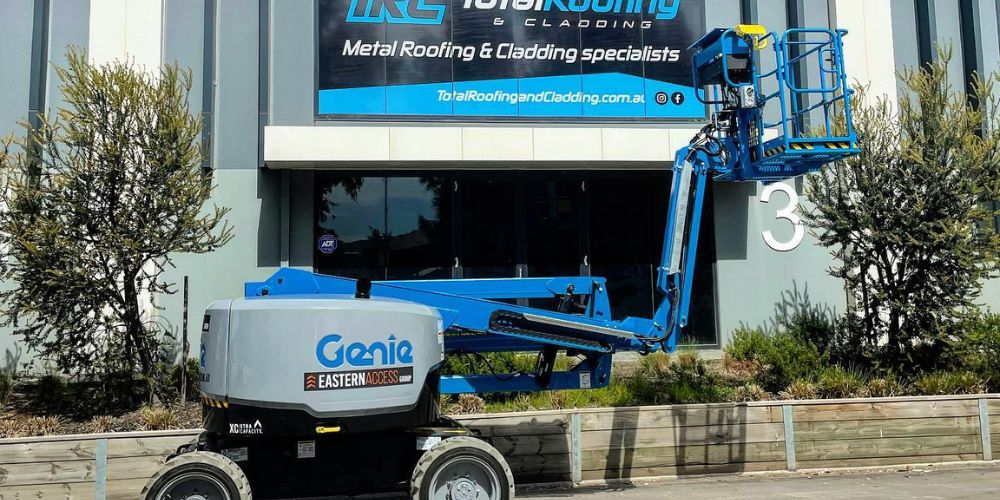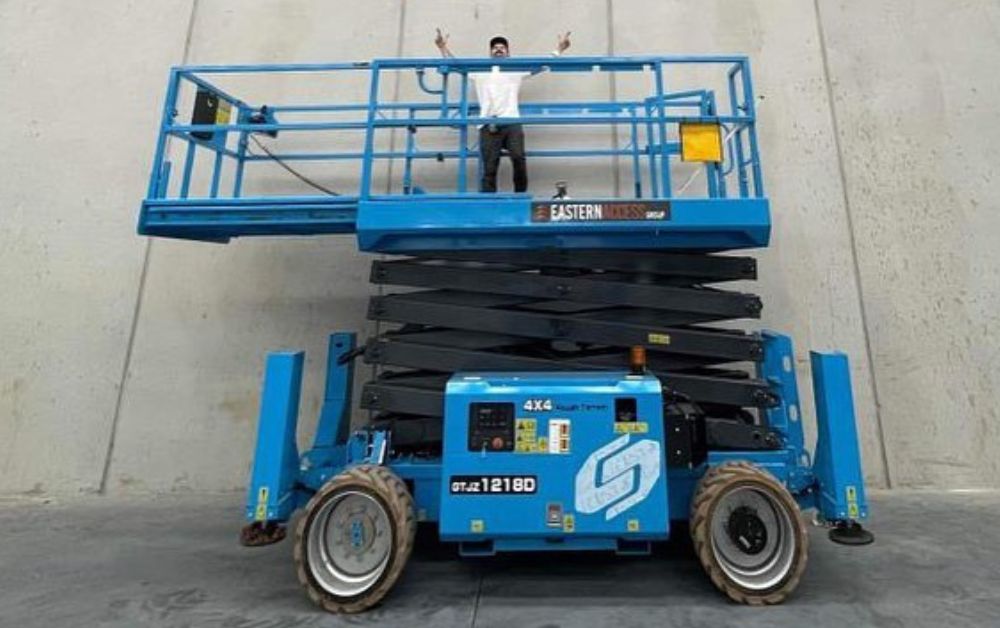How High Can Man Lifts Go?
Table of Contents
Man lifts are quite helpful in different industries. They enable employees to reach high areas safely and efficiently. However, not all man lifts are capable of reaching the same heights. There are several types of man lifts, each with own height reach limitations.
However, knowing the height a man lift can reach is necessary because it can help you determine if a certain lift is appropriate for a given activity.
Have you ever wondered then how far those awesome man lifts can go? In this blog, we’ll look at the highest peaks that man lifts can reach and why they’re important to know.
Understanding Man Lifts
Man lifts, often known as aerial lifts or cherry pickers, are specialised equipment for elevating people and their gear. Traditional techniques such as ladders or scaffolding offer a safe and effective way of reaching high spots that might otherwise be impossible or dangerous. Man lifts are classified as scissors, boom, vertical mast, and articulating lifts. Each kind has distinct characteristics and capabilities tailored to specific jobs and locations. They are commonly utilized in construction, maintenance, utilities, film production, and warehousing. Man lifts are outfitted with safety safeguards to protect workers at elevated heights, and adequate training is required.

Factors Influencing Man Lifts Heights
Several variables influence the highest height that a man lifts can achieve. Understanding these characteristics is critical for choosing the right man lift and ensuring safe and effective operations. The following are the major elements that impact man lift heights:
Lift Type and Design
The height capacities of various types of man lifts differ. Scissor lifts, for example, often have lower maximum heights than boom lifts or vertical mast lifts. The highest height possible is directly affected by the design of the lift mechanism, such as the boom’s extension range or the scissor mechanism’s vertical travel.
Platform Dimensions and Stability
The platform’s size and stability also affect the highest height achieved. Due to stability considerations, larger platforms may have weight or height restrictions. When evaluating height capabilities, it is critical to consider platform size and stability needs for certain jobs.
Environmental Aspects
For example, wind speed and topographical conditions can influence man lift safety at high altitudes. Manufacturers frequently specify wind speed limitations to maintain the lift’s stability and safety.
Considerations for Safety
Man lifts have safety elements to keep users safe while working at heights. Guardrails, harness connection points, and emergency descent mechanisms can all impact the lift’s useable height.
Different Types of Man Lifts and Their Vertical Reach
There are several varieties of man lifts, each with its unique design and vertical reach capabilities. Let’s look at the various varieties and their normal vertical reach ranges:
Scissor Lifts:
Scissor lifts have a vertically moving platform supported by a crisscrossing system of folding supports.
Vertical reach: Scissor lifts may often reach 20 to 60 feet (6 to 18 metres). Some bigger scissor lifts can reach more than 70 feet (21 metres).
Boom Lifts:
Boom lifts can reach vertically and horizontally thanks to an extending arm or boom.
Typical vertical reach: Boom lifts typically have a vertical reach of 30 to 180 feet (9 to 55 metres), depending on the type. Articulating boom lifts typically provide significantly lower maximum heights than straight or telescopic boom lifts.
Vertical Mast Lifts:
Vertical mast lifts feature a single vertical mast and a small platform, sometimes called personnel or one-person lifts.
Typical vertical reach: Vertical reach of vertical mast lifts is typically between 20 and 50 feet (6 and 15 metres). At the same time, certain models may have a slightly higher or lower vertical reach.

Factors To Consider When Choosing Man Lifts
There are various crucial aspects to consider when selecting a man lift for your particular needs. Considering these aspects, you may choose the best man lift for the job, increasing productivity, efficiency, and safety. These are the main elements to think about:
Height Requirements
Determine the vertical height you must climb to complete your assignment. Consider the maximum working height needed while accounting for any obstructions or overhead clearance. Select a man lift with enough vertical reach to provide safe and comfortable access to the required height.
Type of Lift
Man lifts come in various varieties, each with its characteristics and talents. Consider each type’s benefits and drawbacks, such as vertical mast, scissors, and boom lifts. Choose a lift type compatible with the demands of manoeuvrability, the nature of your task, and your working environment.
Weight Limitation
Calculate the total weight of the people using the lift, the equipment, and the materials that will be there. Ensure the man lift you choose has a weight capacity that can easily handle the projected load. The stability and safety may be compromised if the weight restriction is exceeded.
Platform Height
Analyse the platform size required for your work. Take into account how many operators, tools, and pieces of equipment will be present on the platform at once. Make sure the platform size is enough for safe and pleasant operations.
Reach and Articulation
Consider using man lifts with articulating or telescoping booms if your work calls for horizontal reach or access to awkward places. These capabilities let you operate effectively in various office settings, enabling flexibility and precise placement.
Energy Source
Choose the power source that is best for the job at hand. Man lifts can run on diesel, electricity, or hybrid powertrains. Consider your work area’s electricity availability, pollution laws, and noise limits.
Terrain and Environment
Inspect where the man will be utilized for the terrain and surroundings. Consider elements like the terrain, slopes, confined places, or restricted access locations. Select a man lift appropriate for the work area to guarantee safe and effective operation.
Safety Options
Ensure the man lift includes important safety components like guardrails, emergency descent mechanisms, and harness attachment points. Put operator safety first while adhering to safety laws and guidelines.
Maintenance and Training
Examine the knowledge necessary to operate the selected man lift. Make sure operators are given the necessary instruction on the particular lift model and its safety protocols. To guarantee the man lift performs at its best and lasts a long time, consider its maintenance and service needs.
Frequently Asked Questions
Yes, man lifts have weight restrictions that must be adhered to to operate safely. The weight capacity considers the combined weight of the lift platform’s materials, tools, and operators. The stability and safety may be compromised if the weight restriction is exceeded.
Man lifts can accommodate multiple operators. Still, ensuring the lift’s weight limit is maintained is crucial. Operators must also follow safety regulations, which include donning the right PPE and keeping their balance on the platform.
The successful and safe use of man lifts indeed requires sufficient training. The exact lift model, safety protocols, and fall prevention measures should all be included in operator training. In addition to ensuring compliance with industry rules and standards, training helps avoid accidents.
Yes, equipment rental firms frequently provide man lifts for hire or lease. Rather than buying one completely, renting or leasing a man lift might be a more affordable option for occasional or short-term use.
Conclusion
Man lifts are useful and adaptable tools that enable safe access to elevated heights for various occupations and industries. You may make judgements to ensure efficiency and safety in your operations by knowing the many types of man lifts, their vertical reach capabilities, and the elements to consider when choosing one.
Remember to consider your height requirements, the type of lift that best meets your demands, the lift’s weight capacity, platform size, reach and articulation capabilities, the lift’s power source, and the area in which it will be used when choosing a man lift. Safety should always come first, and man lift operators must be trained to use them safely and efficiently.

